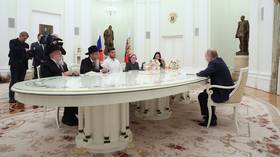Astro droid? Russians build human-like super-robot for remote-controlled spacewalks

A remotely-operated robot reproducing the minutest particulars of a human doing complicated work will be taken into space to do dangerous jobs in orbit. An operational prototype has been demonstrated to the Russian government’s military sci-tech curator.
Military robots under development in Russia won’t be limited to the battlefield only: space applications will have priority, Deputy Prime Minister Dmitry Rogozin told reporters last weekend.
“We’ve launched work to create an avatar that will become a crewmember of the Russian national orbital station,” Rogozin said.
The robot will be able to do spacewalk without armor and do different jobs while its operator remains safely inside the station.
“We believe humanoid robots with synthetic vision and AI in perspective is not a fairytale,” Rogozin said, stressing that “systematic progress” towards putting military technology to civilian and scientific use is needed to maintain Russia’s leadership in the intellectual sphere.

The Advanced Research Foundation has demonstrated two prototypes.
One is a human-like ‘torso’ with two arms, meant to perform precise handling of objects in copycat, supervisory-controlled and autonomous modes. The platform is remotely-controlled by an operator wearing a control suit scanning the fine motor skills of his/her neck, shoulder area, wrists and fingers. These are replicated in the robot.
This prototype can already ‘perform’ tricks such as driving a vehicle or welding. In the future it will have enough intelligence and computing capability to do these jobs autonomously. Engineers have dubbed the avatar robot ‘Fyodor’.
Fyodor is much less limited than a human being. It can operate in dangerous environments, has extra-human power and needs no sleep, and therefore has extended operational capabilities.
“It has no ‘human factor’: it never gets distracted, never gets ill, has no emotions and always focuses on the task,” head of the Savior robotic program Sergey Khurs told Vesti media outlet.
Another prototype is an anthropomorphic platform needed to develop human-like mobile equilibrium, kinetics and complex coordination of manipulators. This prototype is simultaneously operated by an operator and programs and can automatically restore vertical position when it falls.

Engineers also presented to government an operational model from another branch of modern robotics - a prototype of military exoskeleton for augmented human performance. The robotic suit not only provides a soldier with multiplied extra power; combined with communication equipment onboard, it can project information from a drone or command post to serviceman’s helmet screen and can assist with aiming to ensure pinpoint firing from behind cover, without seeing a target.















